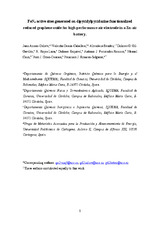FeN4 active sites generated on dipyridylpyridazine functionalized reduced graphene oxide for high-performance air electrode in a Zn-air battery
Autor
Amaro-Gahete, J.
García-Caballero, Valentín
Benítez de la Torre, A.
Gil-Gavilán, Dolores
Rojas-Luna, Raúl
Esquivel, Dolores
Fernández Romero, Antonio
Cano, Manuel
Giner-Casares, Juan J.
Romero-Salguero, F.J.
Editor
ElsevierFecha
2023Materia
Reduced graphene oxideDiels-Alder functionalization
FeN4 active site
Oxygen reduction reaction
Zn-air battery
METS:
Mostrar el registro METSPREMIS:
Mostrar el registro PREMISMetadatos
Mostrar el registro completo del ítemResumen
The growing global electricity demand requires the development of cost-effective energy conversion and storage systems, integrating inexpensive, eco-friendly, and high-efficiency catalysts. Oxygen reduction reaction (ORR) is considered crucial process to achieve high-power-density fuel cells and Zn-air batteries (ZABs). The latter have attracted the attention of scientific community due to its high theoretical energy density, reliable safety and low-cost. However, several limitations must be overcome, designing ORR catalysts thought versatile and economical synthetic routes. In this sense, the non-noble iron–nitrogen-carbon materials (Fesingle bondNsingle bondC) have been reported as the most potential candidates for attaining superior activity toward ORR in substitution of the high-priced commercial Pt-C catalysts. Herein, Diels-Alder surface adducts based on dipyridylpyridazine units have been created along 2D surface of reduced graphene oxide (rGO) nanosheets for the controlled generation of FeN4 active sites at the edges through successive solvent-free mechanochemical reactions and an additional thermal treatment. The optimized catalyst provided high content of pyridinic-N, graphitic-N and Fe2+ species, contributing to the excellent activity delivered as electrocatalyst for ORR processes. In addition, a flooded ZAB assembled with this material as cathodic/air electrode exhibited excellent specific capacities of 4.94 and 2.77 A·h·g−1 at -1 and -5 mA, respectively, improving the catalytic performance obtained for the 10 wt% Pt-C benchmark electrocatalyst.
Descripción
Embargado hasta 01/11/2025

